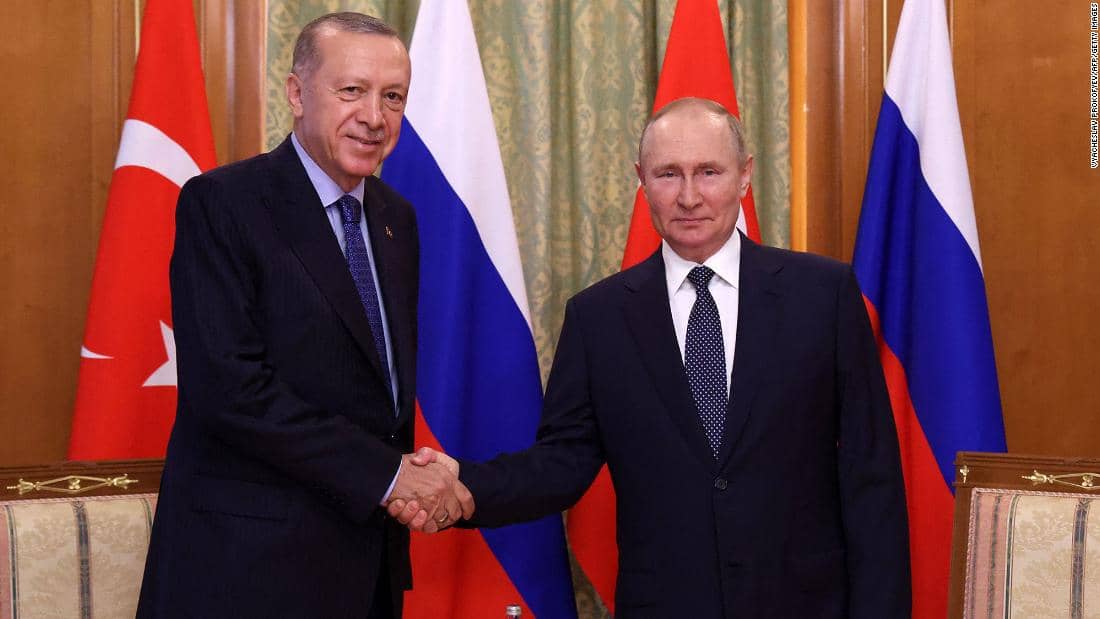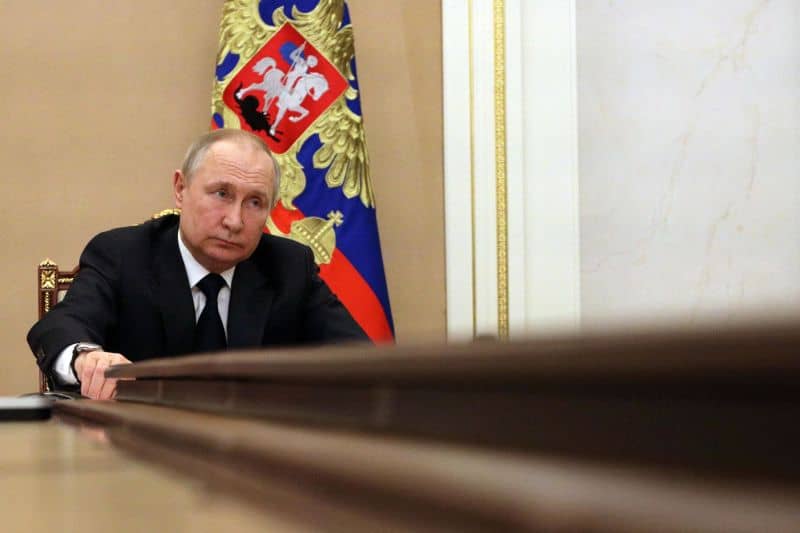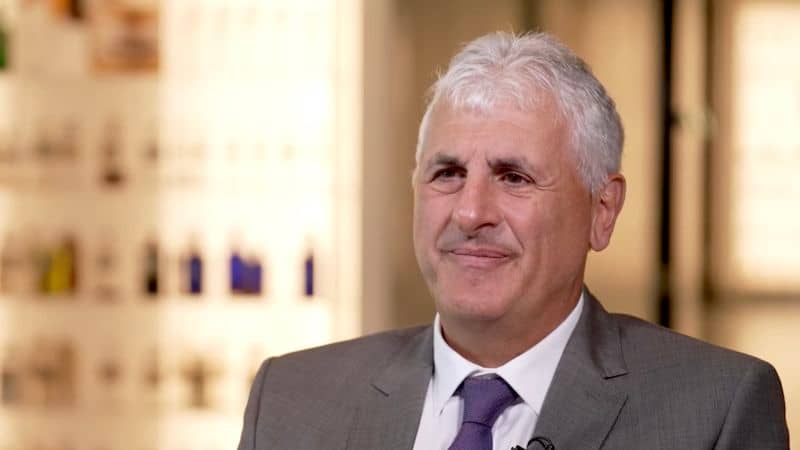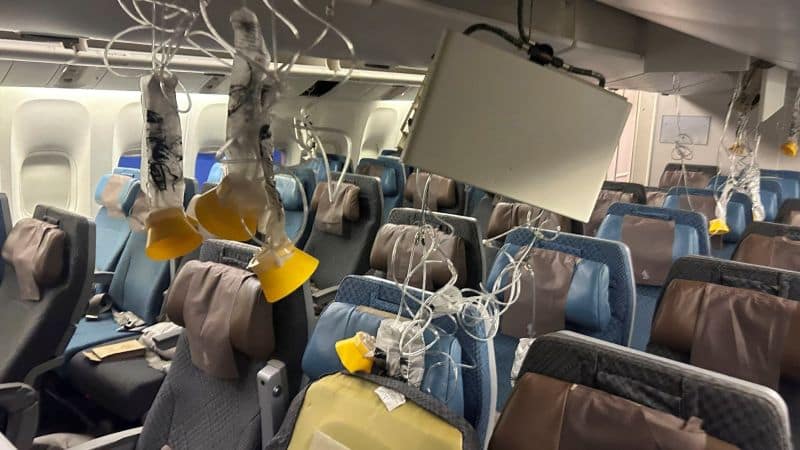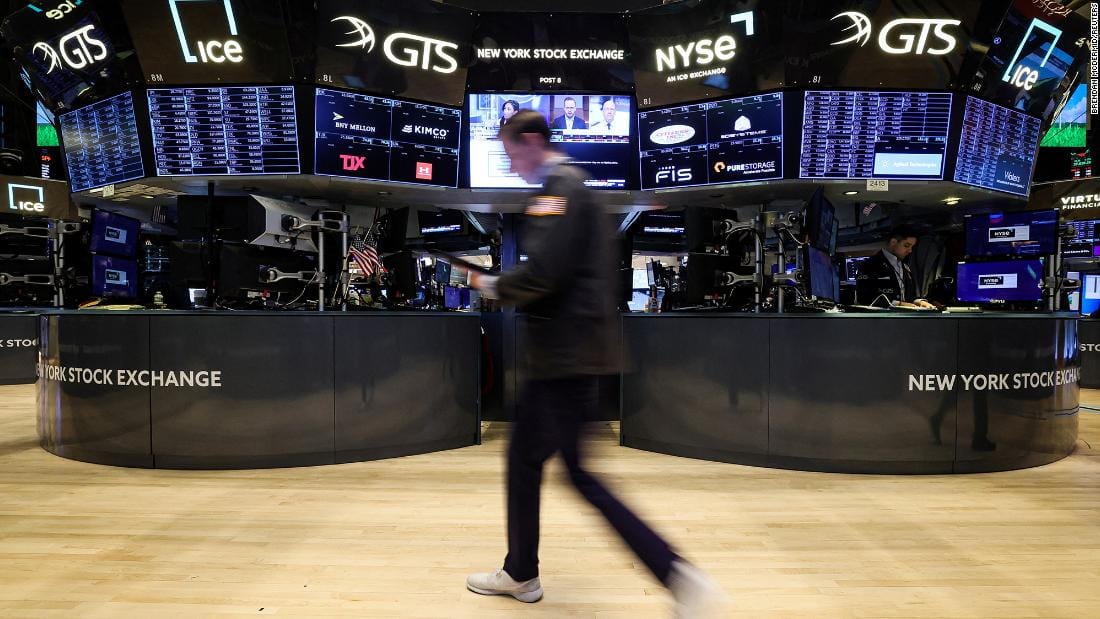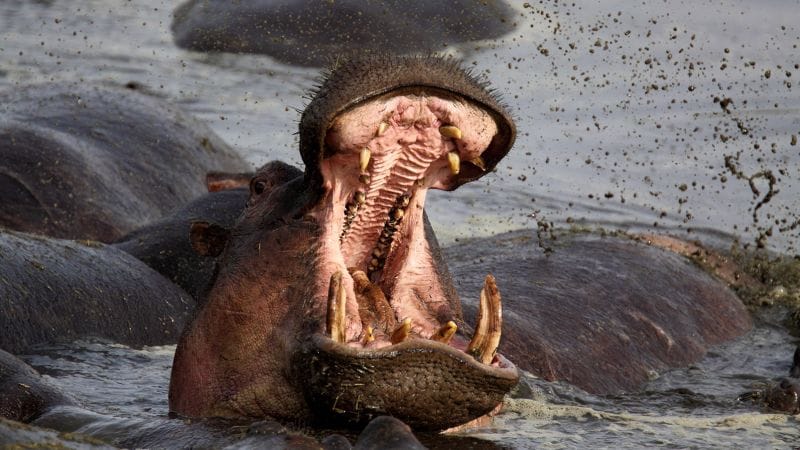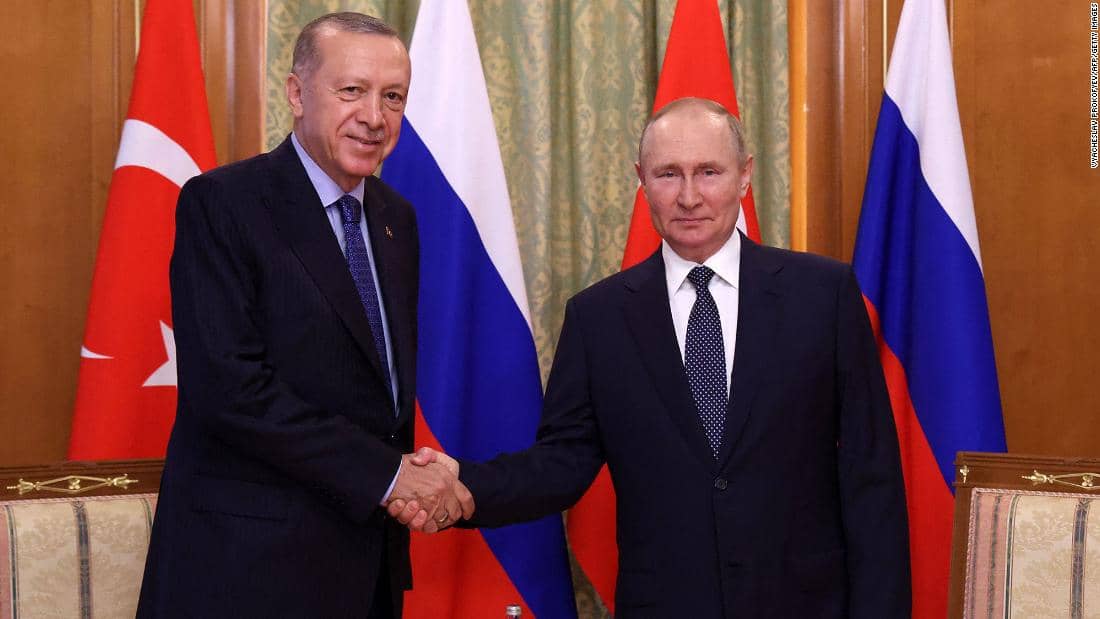But in other ways, some of the region’s countries have prospered immensely as the fighting rages on, adding hundreds of billions of dollars to their coffers. Here are four ways the Ukraine

‘Putin is a killer,’ says Ukraine goalkeeper as he sends a message of hope to his country
Shaktar Donetsk and Ukraine goalkeeper Anatoliy Trubin talks to CNN Sport about doing his part to help his nation survive the Russian invasion.
Don't Miss
London CNN — When Africa needs medicines, all too often the continent must look abroad. African nations consume about 25%
US national security adviser Jake Sullivan confirmed Sunday that the US will allow European countries to start training Ukrainian fighter
A view of the Kremlin in Moscow, Russia, on September 19, 2021. (Alexander Nemenov/AFP/Getty Images) Senior Russian officials at the
Live updates: Russia’s war in Ukraine

US national security adviser Jake Sullivan confirmed Sunday that the US will allow European countries to start training Ukrainian fighter pilots to use F-16 fighter jets, after reports that Europe was awaiting formal approval.
“Yes, we will,” Sullivan told CNN’s Jake Tapper when asked. “The president has given a green light and we will allow, permit, support, facilitate and in fact provide the necessary tools for Ukrainians to begin being trained on F-16s, as soon as the Europeans are prepared.”
Sullivan noted that European leaders have said they need several weeks to prepare training abilities and that the US would meet whatever timeline they set out.
“The United States will not be the hold up in ensuring that this F-16 training can get underway,” he said.
Remember: Ukraine’s quest for the superior US-made fighter jets received a huge boost when the Biden administration said in May that it would back a training program for pilots and would not disallow allies from supplying Kyiv with the planes. But the US has not said that it will supply Kyiv with F-16s directly.
What US lawmakers are saying: Sen. Mark Kelly, an Arizona Democrat and former Navy pilot who sits on the Armed Services Committee, defended the timeline for directly supplying the fighting aircraft to Ukraine.
Responding to perceived criticism that the administration is slow-walking the decision to send F-16s, Kelly said in an interview with CNN on Sunday that it will take time and resources to train Ukrainian pilots on how to fly the aircraft in the first place.
“This is going to take some time. I don’t think it’s been slow-walked, but the process is a lot longer,” Kelly said, adding that during a visit to Ukraine in April, President Volodymyr Zelensky and his team still weren’t certain what specific combat missions they wanted to use the jets for.
By contrast, Sen. Dan Sullivan, an Alaska Republican and former Marine who also sits on the Armed Services Committee, criticized the Biden administration’s approach.
While he praised Biden for his actions at the recent summit for the NATO military alliance, he criticized the administration for “slow-rolling” weapons systems to Ukraine, specifically citing the F-16s.
“As I predicted, they’re eventually going to do it, but it’s too darn long. That’s exactly what happened,” said Sullivan.
Don't Miss
‘Putin is a killer,’ says Ukraine goalkeeper as he sends a message of hope to his country Shaktar Donetsk and
The aviation tracking site FlightRadar24 says, based on its data, that the turbulence on Singapore Airlines flight SQ321 occurred over
Stocks slid Friday after a slate of earnings beats from big banks fueled concerns that the Federal Reserve will raise
Live updates: Russia’s war in Ukraine

Senior Russian officials at the Kremlin and in the regions have been forbidden from leaving their posts, claims IStories, an independent Russian media outlet.
IStories is an online investigative news outlet based outside Russia and is run by a well-known journalist Roman Aninn, who said his sources included acquaintances of high-ranking officials in the Presidential Administration.
Aninn told CNN he did not know how many people had tried to quit but had not been allowed to. “However, I know of concrete examples of those who tried to quit. These are governors, [from the] security forces, and people from the presidential administration,” he said.
The journalist declined to provide names so as to protect his sources.
IStories said it had been told by a former officer of the Federal Security Service (FSB) that he knew of “at least two cases when governors tried to leave their posts,” but the Internal Policy Department of the Presidential Administration had banned them from resigning and had hinted at criminal cases against them.
There is no way to verify the claims, and Kremlin spokesperson Dmitry Peskov told CNN on Tuesday that reports about high-ranking officials being banned from resigning for the duration of the “special military operation” — as Moscow refers to the war in Ukraine — were “another hoax.”
Aninn said the policy was not formal and never conveyed in writing. “There can be no written refusals or recommendations, because the ban is illegal. It all happens informally. A governor of the region submits his resignation, he is summoned to the Department of Internal Policy, intimidated, called a traitor and threatened with a criminal case if he insists,” he noted.
According to a presidential decree, servicemen under contract (which would include the majority of FSB employees) cannot leave even after their contract expires.
The ban has two goals, Aninn said. If many people leave, then public administration may become unmanageable, so the ban would “prevent the loss of control,” he said, adding that the other goal is to “show the people and subordinates that the authorities are united, that everyone is in place and no one is going to run away.”
Don't Miss
‘Putin is a killer,’ says Ukraine goalkeeper as he sends a message of hope to his country Shaktar Donetsk and
The aviation tracking site FlightRadar24 says, based on its data, that the turbulence on Singapore Airlines flight SQ321 occurred over
Stocks slid Friday after a slate of earnings beats from big banks fueled concerns that the Federal Reserve will raise
Live updates: Russia’s war in Ukraine

Turkish President Recep Tayyip Erdogan announced an extension of the Black Sea grain deal Saturday, but he did not specify a new expiration date.
The deal, which was brokered by the United Nations and Turkey last July to guarantee safe passage for ships carrying vital grain exports from Ukraine, had been set to expire today.
“As a result of our negotiations with both parties, we extended the agreement period,” Erdogan said at an event in Turkey’s Çanakkale province.
“This agreement, which has provided the shipment of 25 million tons of grain to the world markets with more than 800 ships to date, is of vital importance for the stability of the global food supply,” Erdogan added. “I would like to thank the Russian and Ukrainian parties and the UN secretary general for their efforts to extend the agreement once again.”
The United Nations praised the extension in a statement.
“We remain strongly committed to both agreements and we urge all sides to redouble their efforts to implement them fully,” said Stéphane Dujarric, a spokesperson for the UN secretary-general.
Some context: The agreement comes after Russia said Monday it had agreed to a 60-day extension of the deal, while the UN emphasized on Thursday that the deal stated it would be extended for 120 days — not 60.
Why the grain deal is important: Ukraine and Russia are both significant suppliers of food to the world. Ukraine – known as one of the globe’s breadbaskets — normally supplies about 45 million metric tons of grain to the global market every year and is the world’s top exporter of sunflower oil. Together with Russia, it accounted for about one-quarter of global wheat exports in 2019.
Before Russia invaded Ukraine, the price of food was already at its highest level in a decade due to scrambled supply chains from the Covid-19 pandemic and extreme weather events.
In 2022, the number of people grappling with acute food insecurity — meaning their access to food was so restricted that it threatened their lives and livelihoods — shot up to 345 million from 135 million in 2019.
CNN’s Julia Horowitz contributed reporting to this post.
Don't Miss
‘Putin is a killer,’ says Ukraine goalkeeper as he sends a message of hope to his country Shaktar Donetsk and
The aviation tracking site FlightRadar24 says, based on its data, that the turbulence on Singapore Airlines flight SQ321 occurred over
Stocks slid Friday after a slate of earnings beats from big banks fueled concerns that the Federal Reserve will raise
Live updates: Russia’s war in Ukraine

Europe is scrambling to buy diesel fuel from Russia before a ban on imports comes into force in early February, but the frantic stockpiling is unlikely to prevent a new price shock for truckers, drivers and businesses.
In the first two weeks of January, European countries snapped up almost 8 million barrels of Russian diesel, according to energy data provider Vortexa, roughly on par with imports this time last year before Russia invaded Ukraine. Imports in the fourth quarter of 2022 were up nearly 19% on the same period the previous year.
Russia is the bloc’s biggest supplier, making up 29% of its total diesel imports last year, data from Rystad Energy shows.
Since Russia’s invasion in February last year, the European Union has made a huge effort to wean itself off Moscow’s oil and natural gas supplies.
EU countries drastically reduced their imports of crude from Russia ahead of the ban, but that isn’t happening with diesel because it’s much harder to find alternative sources of the fuel.
The EU ban will tighten the global market for diesel, according to Mark Williams, a research director at Wood Mackenzie, told CNN — unless Russia can successfully divert its cargoes to Latin America and Africa, regions which typically import from the United States. That would free up US barrels to be sent to Europe, plugging the gap left by Moscow, he said.
But importing diesel from suppliers further afield, including the United States and Saudi Arabia, will push up freight costs, feeding into higher consumer prices, he said.
“We are expecting diesel prices to rise in Europe. We’re expecting a spike sort of February, March time,” Williams said.
According to Wood Mackenzie’s estimates, the price of a barrel of diesel will average $40 for the first three months of this year. That’s up a whopping 470% from the average price for the whole of 2021, before Russia’s invasion sent prices soaring.
Read more here.
Don't Miss
‘Putin is a killer,’ says Ukraine goalkeeper as he sends a message of hope to his country Shaktar Donetsk and
The aviation tracking site FlightRadar24 says, based on its data, that the turbulence on Singapore Airlines flight SQ321 occurred over
Stocks slid Friday after a slate of earnings beats from big banks fueled concerns that the Federal Reserve will raise
Live updates: Russia’s war in Ukraine
Ten million Ukrainians are without power just as temperatures fall to freezing and below after more Russian missile attacks, President Volodymyr Zelensky said. CNN spoke to Kyiv residents and how they’re coping under these conditions.
Volodimyr Hontar, 32, is the head of the training department of the Emergency Medical Care Center in Kyiv. Due to the nature of his work, ambulance stations are always independent of power outages and have electricity. However, it’s when he comes home that problems begin.
“I live on the 9th floor, it’s hard to go up without the elevator, which is turned off during power outages,” he says. “But with my wife, it’s romantic by candlelight in the evenings.”
But Hontar is most concerned about soldiers at the front line. He says that if they’re alright, everyone will be alright.
Olena Kravchuk, 35, is a utility worker who lives in Irpin and works in Kyiv. The blackouts aren’t affecting her job because she works outside, but at home, her kids have trouble logging into school online and miss classes.
“If there is no electricity and gas, there will be no heat, we are very worried about it,” Kravchuck says. “When you come home from work, there’s no light, you can’t call your children, there’s no cell phone or internet.”
Elena Khaykina, 63, and Larisa Polyakova, 66, are pensioners displaced from Kharkiv who have been living in Kyiv for the past three months. Both women are very concerned about their loved ones who remain in Kharkiv.
“My son in Kharkiv has no electricity 24 hours a day, it worries me a lot,” Polyakova says. The power cuts are not as intense in the capital.
“We are from Kharkiv, and we are united here in Kyiv and try to support each other,” Khaykina says. The windows in her Kharkiv apartment are broken from shelling, and she cannot go back and survive winter there.
Bogdan, 30, is a food delivery man in Kyiv. Bogdan, who did not want to give his last name, says power outages affect his work because many cafes have to close, and there are less orders.
He also finds it difficult to charge his electric bike that he uses for deliveries. Heavier snow will make it more difficult to bike around the city.
When there is no power at home, he listens to audiobooks downloaded on his phone.
He worries about the soldiers in the trenches facing a harsh winter. And the rest, he says, “we will get through the rest.”
Don't Miss
‘Putin is a killer,’ says Ukraine goalkeeper as he sends a message of hope to his country Shaktar Donetsk and
The aviation tracking site FlightRadar24 says, based on its data, that the turbulence on Singapore Airlines flight SQ321 occurred over
Stocks slid Friday after a slate of earnings beats from big banks fueled concerns that the Federal Reserve will raise
Ukraine: Here’s what comes next for the conflict
Until a few weeks ago, it looked as though the conflict in Ukraine would head into the bitter winter months frozen in place – with neither side making appreciable progress.
That prognosis has changed with the sudden and successful Ukrainian offensive through most of occupied Kharkiv, which has galvanized Ukraine’s Western backers as much as it has led to recriminations in Moscow.
The Russian military must now ask itself what sort of force, and where exactly they are deployed, can regain the initiative after Ukraine captured more territory in one week than Russian forces had in five months.
There are important political dynamics involved too. The Kremlin faces tough choices: whether to declare a general mobilization to reinvigorate its increasingly ragged units in Ukraine and how to manage a budget deficit – even though it’s sitting on historically high foreign reserves.
Far beyond the theater of war, Russia must choose how far to weaponize its influence over Europe’s gas supply, as governments prepare to spend big to mitigate the effects of exceptionally tight supply.
Another potential dilemma: the first signs that Chinese support for the Russian invasion, never whole-hearted, may be waning.
Ukraine’s stunning counter-offensive across Kharkiv, combined with more attritional advances in the south, have presented the Kremlin and Russia’s much criticized Defense Ministry with a range of bad options.
As winter approaches, they must choose which front to prioritize, and whether to double down on efforts to fulfill Putin’s stated objective: the seizure of Donetsk and Luhansk regions. The Russians currently hold about 20% of Ukrainian land, including Crimea and parts of the south.
Taking Donetsk is a taller order now for the Russians. Seven months of war have shown the shortcomings in Russian logistics, which will get no easier in wetter, colder weather.

In a matter of days, Russia lost one of three axes of attack in Donetsk; no progress has been made on the other two since the end of June.
At the same time, Russian defenses in Kherson are under growing pressure despite being reinforced, thanks to Ukraine’s success in cutting off resupply across the River Dnipro and in targeting command posts and ammunition depots.
The Russian military does not have a wealth of fresh units to inject into the conflict. The recently stood-up 3rd Army Corps largely comprises volunteer battalions recruited across the Russian regions. Other battalion tactical groups have been reconstituted after suffering heavy losses. There are persistent reports of discipline fraying among Russian units. The disorderly retreat in Kharkiv, with vast amounts of military hardware abandoned, is testament to that – and to chronic command problems that will not be remedied overnight.
Obviously, Ukraine has also lost thousands of soldiers, including many from its best units in Donbas. And a NATO military official told CNN that while the sweep across Ukraine had been a major boost for morale, “I can’t imagine the same thing happening twice.”
And Russia’s artillery and rocket forces still vastly outnumber those of Ukraine. But it’s been unable to leverage this superiority into gains on the ground. Some 40% of Donetsk remains under Ukrainian control.
President Vladimir Putin acknowledged this on Friday – saying that the offensive operation in the Donbas “goes at a slow pace, but it keeps going. Gradually, gradually, the Russian army occupies new territories.”
And despite calls in Moscow for a general mobilization, this still seems unlikely. Putin said: “We are fighting with only part of the Russian army, the part that’s on contract …Therefore, we are not in a hurry on this part.”
Some observers have begun to ask whether a Ukrainian victory is conceivable. That depends on how victory is defined. It is President Zelensky’s stated intention to recover all occupied territories as well as Crimea.
General David Petraeus, former CIA Director and commander of US military forces in Iraq, said he expected Ukraine to retake territory seized by the Russians since February, and “it’s even conceivable they could retake Crimea and the Donbas,” aided by growing resistance in occupied areas.
But that would take time and involve tough fighting, Petraeus told CNN. If that were Ukraine’s goal, its supply lines would be stretched and its better units spread thin. In turn, Ukrainian forces would be vulnerable to counter-attacks.
Ultimately, Ukraine’s battlefield success will depend on a continuing and expanded supply of Western hardware. Meetings in the next few weeks will determine what’s in that pipeline, but inventories in several countries are dwindling.

US officials are also wary that Ukraine might overplay its hand. The US is still exceptionally cautious about sending Ukraine weapons that have a range of more than 80 kilometers (nearly 50 miles) and could therefore strike deep inside Russia. It has so far resisted Ukrainian requests for long-range Army Tactical Missile Systems (ATACMS) that have a range of up to 300 kilometers.
Some Western officials fear humiliation for the Kremlin might provoke an unpredictable reaction, even including tactical nuclear weapons.
A former NATO deputy secretary-general, Rose Gottemoeller, told the BBC this week: “I do worry about that kind of scenario at the moment… The goal would be to try to get the Ukrainians in their terror to capitulate.”
Back in February, on the eve of the invasion, Putin warned that any country standing in Russia’s way would face “consequences such as they have never seen in their history.”
But Olga Olika, director of the Europe and Central Asia Program at the International Crisis Group, believes the Kremlin would not countenance such an escalation because “detonating weapons of mass destruction would provoke international retaliation, including, quite possibly, direct military involvement from NATO.”

US President Joe Biden appeared to confirm this in a “60 Minutes” interview – a clip of which aired on CBS Evening News on Friday. He warned Putin against escalating the fighting further in Ukraine, saying that there will be consequences if the Kremlin used chemical or nuclear weapons in the fighting.
“Don’t. Don’t. Don’t. It would change the face of war unlike anything since World War II,” Biden said. Asked by Scott Pelley what the US response would be if Russia used a chemical or nuclear weapon, Biden said it would be “consequential.”
See Biden’s warning to Putin over nuclear weapons
Other analysts point out that the use of tactical nuclear weapons would have limited military benefits, and that the military might even defy an order from Putin for their use.
“It is hard to imagine that even nuclear strikes would allow Russia to break Ukraine’s will to resist,” said General Valerii Zaluzhnyi, Ukraine’s Armed Forces commander in chief.
Russia still has an intimidating arsenal of ballistic and other missiles that could be used not to gain territory but to inflict catastrophic damage on Ukraine’s infrastructure: power, water and communications.
On Russian state television, pundits have argued for Ukraine’s power and water infrastructure to be destroyed. And there have been signs of Russian missile forces doing just that – with attacks on power supplies in Kharkiv and hydraulic gates on a reservoir in Kryviy Rih in recent days.
Nevertheless, the trajectory of the war looks different heading into the final months of a year that began with few hopes Ukraine could resist the Russian behemoth. That in itself may stiffen the backbone of European support – and spur the continuing pipeline of military aid – despite an expensive winter of discontent over heating and fuel prices.
It’s long been evident that part of the Kremlin’s strategy is to knee-cap European resolve in supporting Ukraine by plunging it into an energy crisis, literally turning off the gas taps.
At a forum in Vladivostok earlier this month, Putin said: “We will not supply anything at all if it is contrary to our interests. No gas, no oil, no coal, no fuel oil, nothing.”
Amid setbacks on the battlefield, Ivo Daalder and James Lindsay write in Foreign Affairs that “Putin’s best hope — perhaps his only hope — is that Western support for Ukraine will crumble as the costs of war, including energy shortages and rising prices, begin to hit home in Europe.”

Natural gas prices in Europe are 10 times higher than a year ago, earning Russia about $1 billion a day in the first three months of the conflict from energy exports. And the sanctions regime against Russia will only have significant impact in the longer-term, because the Russian economy is so self-contained.
But the coming winter will be the acid test of Moscow’s energy squeeze. Rather than looking for compromise, European governments have concluded that concessions would only embolden the Kremlin. They are set on heavy spending to protect consumers and a longer-term strategy to reduce dependence on Russian energy. After scouring the world for alternative suppliers, they have built up reserves (in France’s case to more than 90% of capacity).
Even though wholesale gas prices are still numbingly high, they have fallen by about one-third in the last three weeks. Some analysts think they will further do so, reducing the cost of subsidies being introduced by European governments already strapped for cash.
There are also signs that Russia’s windfall from sky-high oil and gas prices may have peaked. The International Energy Agency forecasts that Russian oil production will be 17% lower by next February compared to pre-war output, once the full force of EU sanctions are felt.
Daalder and Lindsay believe Ukraine’s allies have set their course. “Many skeptics in the West believe democracies will buckle in the face of hardship,” they wrote. “But such voices underestimate the West’s staying power.”
The signals from both sides indicate they are digging in for a long winter, rather than exploring prospects for a settlement.
“Russia will do everything to end the conflict in Ukraine as quickly as possible, but Kyiv refuses to negotiate,” Putin said at a meeting with Indian Prime Minister Narendra Modi on Friday. In the meantime, Russia’s goal was still “the liberation of Donbas” and there was “no hurry.”
But the Russian leader also acknowledged the “concerns” that both India and China have about the conflict.
Chinese leader Xi Jinping, in his first meeting with Putin since before the invasion, notably did not refer to Ukraine by name, according to a read-out from Beijing. Some observers believe Beijing is subtly adopting an arm’s length approach to the Russian quagmire in Ukraine. How that may play into Putin’s calculations is as yet unknown.
For their part, the Ukrainians have been consistent about not negotiating with Moscow unless and until all occupied territory is recovered. Zelensky has angrily rejected suggestions from French President Emmanuel Macron, former US Secretary of State Henry Kissinger and others that Ukraine should negotiate so as not to humiliate Russia (Kissinger later withdrew his recommendation).
Given the current state of the battlefield, there is little incentive for Ukraine to seek a truce, while the Kremlin would be hard pressed to spin the results of its “special military operation” if one-third of the Donbas is still in Ukrainian hands.
Former CIA Director and retired US Army general David Petraeus believes Russia faces a “disastrous situation” militarily. He told CNN Russia was “literally running out of soldiers, ammunition, tanks, fighting vehicles and so forth.”
A NATO military official told CNN that he expected Putin would have to rethink his position by next spring “if NATO stays united over the winter’s energy problems and if Ukraine keeps up the fight. But he won’t negotiate earlier, as a cold winter is his best weapon.”
After that, the full effect of embargoes on Russian energy by Western governments and Japan, and on the export of high-tech equipment to Russia will begin to bite. The latter is already beginning to take a toll on weapons production, forcing the military to dust off arms that had been in storage.
The Ukrainian conflict has thrown up plenty of surprises – and predictions may be a fool’s errand. The current shape of the battlefield suggests that the initial roles of Ukraine and Russia – defense and attack – may be reversed in coming months, while Russian forces double down on remorseless bombardment of civilian and military targets.
Don't Miss
What to know about the Trump indictment on the eve of his court appearance Source link
CNN — Paul Templer was living his best life. He was 28 and conducting tours in his native Zimbabwe, with
‘Putin is a killer,’ says Ukraine goalkeeper as he sends a message of hope to his country Shaktar Donetsk and
But in other ways, some of the region’s countries have prospered immensely as the fighting rages on, adding hundreds of billions of dollars to their coffers.
Here are four ways the Ukraine war has affected the Middle East over the last six months:
Energy exporters are cashing in
Strongmen feel emboldened
Regional strongmen that once came under harsh criticism from the West appear to be back in favor.
The war has also allowed Turkish President Recep Tayyip Erdogan to position himself as an indispensable figure in the international order. Faced with a sinking economy at home and elections next year, he has skillfully used his country’s geopolitical position to extract concessions for Turkey abroad by delaying the accession of Nordic countries to NATO. Erdogan has also maintained cordial relations with Russia while publicly opposing the war, selling coveted drones to Ukraine and even mediating between the belligerents.
Alliances are shifting
Food and inflation crises raise tensions
The first ship carrying grain left Ukraine on August 1 and was initially bound for Lebanon. The shipment however changed course after Lebanese buyers refused the delivery, so it sailed to Egypt instead, according to Reuters.
The digest
US airstrikes hit Iran-backed groups in Syria
The US military conducted airstrikes Tuesday targeting Iran-backed groups in Syria’s Deir Ezzor, US Central Command said in a statement. The strikes targeted “infrastructure facilities used by groups affiliated with Iran’s Islamic Revolutionary Guard Corps.” No one was killed in the attack, according to an initial assessment by the US military, but a Syrian activist group said at least 10 people were killed and three were wounded.
- Background: American troops have been present in Syria since 2015 to combat the Islamic State, which has often brought them into conflict with Iran-backed groups. Israeli airstrikes targeted the warehouses at the same location in January 2021, according to Syria’s state news agency. The attack comes amid reports of indirect talks on reviving the nuclear deal between Iran and the US reaching an advanced stage.
- Why it matters: As talks advance, the US may be sending a message that even though it is working on reaching an agreement with Iran, it will continue to target Iran-backed groups in the region. Washington has refused to remove the Iranian Revolutionary Guard Corps from its list of terrorist organizations, which Tehran had previously demanded.
Turkey says it has no preconditions for dialogue with Syria
In a softening of its stance, Turkish Foreign Minister Mevlut Cavusoglu said Ankara has no preconditions for dialogue with Syria but any talks should focus on security on their border.
- Background: Turkey cut ties with Damascus 10 years ago in response to the uprising in Syria and backed rebels fighting to topple the Bashar al-Assad regime. But Turkey has in recent years maintained contact with the regime, directly through intelligence channels and indirectly through the Astana Group process, which aims to solve the Syrian civil war.
- Why it matters: Turkish President Erdogan has indicated he wants to launch yet another military incursion into northeast Syria. Over decades of tension, Turkey has already launched three military operations against Kurdish fighters in Syria’s north, the latest of which was in 2019. Asked about prospects for talks, Cavusoglu said they would need to have specific goals. “No conditions for dialogue, but what is the aim, the target? It needs to be goal-oriented,” he said.
Beirut port silo collapses two years after fatal blast
The northern wheat silo damaged after the deadly Beirut port blast in 2020 collapsed on Tuesday, state-run NNA reported. A large dust cloud was sent into adjacent areas of the port after the implosion as smoke from fires continued rising from the debris.
- Background: On August 4, 2020, hundreds of metric tons of ammonium nitrate ignited, sparking a massive blast in the Lebanese capital’s port, killing more than 215 people and injuring thousands. The silos had been on fire since then. Over the past month, segments of the silos were collapsing gradually as the army continued cordoning the area.
- Why it matters: The silos had become a symbol of dysfunction in Lebanon. Earlier this year the government had rolled out a plan to demolish them. Civil society groups, who see the silos as a memorial to the blast, reacted with outrage, and the plan was scrapped.
What to watch
Water shortages have turned the lush green marshlands of Iraq into a desolate desert. Watch Jomana Karadsheh’s report on the effect of climate change in the country.
What’s trending
Lebanon: #Bachir_Gemayel
Twitter users in Lebanon are marking 40 years since Bashir Gemayel was elected President by the country’s parliament. He was assassinated before taking office in 1982.
A deeply divisive figure in Lebanon’s history, Gemayel founded and led the Lebanese Forces, the military wing of the Christian Phalange party that continues to play a role in the nation’s politics today. He was supported by many Lebanese Christians but considered a traitor by others for his cooperation with Israel, which invaded Lebanon in a 1982 war.
In October 2017, Habib al-Shartouni, a member of Lebanon’s Syrian Social Nationalist Party, was found guilty in absentia by a Lebanese court for planting the bomb that killed Gemayel.
Oman: #Turn_on_Discord
Omanis have turned to Twitter to complain about not being able to access popular social media platform Discord.
With over 150 million active monthly users, Discord plays a big role in the lives of gamers as it serves as a chat room for private games as well as those streaming their games.
Discord also grew to become a significant element in the utility function of non-fungible tokens (NFTs), which are growing in popularity around the Gulf states.
Saudi Arabia: #How_many_wives_would_you_take
While one user said marriage is not a “priority” for him, while another lamented that men could hardly attend to one wife. One user tweeted a photo with the number three.
Islam allows men to take up to four wives. While the practice isn’t widely adopted in the Muslim world, it isn’t uncommon either. Women can only take one husband.
Don't Miss
‘Putin is a killer,’ says Ukraine goalkeeper as he sends a message of hope to his country Shaktar Donetsk and
US national security adviser Jake Sullivan confirmed Sunday that the US will allow European countries to start training Ukrainian fighter
A view of the Kremlin in Moscow, Russia, on September 19, 2021. (Alexander Nemenov/AFP/Getty Images) Senior Russian officials at the

